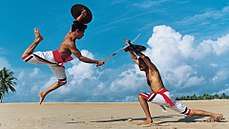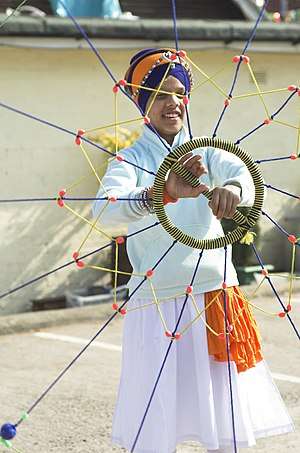Gatka
|
Gatka demonstration in Bedford, England (2007) | |
| Focus | Weaponry |
|---|---|
| Country of origin |
|
| Olympic sport | No |
| Part of a series on |
| Indian martial arts |
|---|
 |
| Styles |
|
| Legendary Figures |
| Notable Practitioners |
| Related terms |
Gatka (Punjabi: ਗਤਕਾ Urdu: گٹکا gatkā) is the name of a Sikh religion martial art associated with the Sikhs of the Punjab region. It is a style of stick fighting, with wooden sticks intended to simulate swords.[1] The Punjabi name gatka properly refers to the wooden stick used. The word originates as a diminutive of Sanskrit gada "mace".[2]
The style originated in later 19th century, out of sword practice in the British Indian Army, from the 1880s. There has been a revival during the later 20th century, with an International Gatka Federation was founded in 1982 and formalized in 1987, and gatka is now being popularized as a sport of sikh martial art and is often shown during Sikh festivals.[3]
History

During the Indian Rebellion of 1857, the Sikhs assisted the British in crushing the mutiny. As a consequence of this assistance, restrictions on fighting practices were relaxed, but the Punjabi martial arts which re-emerged after 1857 had changed significantly. The new style applied the sword-fighting techniques to the wooden training-stick. It was referred to as gatka, after its primary weapon. Gatka was used mainly by the British Indian Army in the 1860s as practice for hand-to-hand combat. As Sikh colleges opened during the 1880s, European rules of fencing were applied to create what is now called sport gatka.
The Defendu system devised by Captain William Ewart Fairbairn and Captain Eric Anthony Sykes borrowed methodologies from gatka, jujutsu, Chinese martial arts and "gutter fighting". This method was used to train soldiers in close-combat techniques at the Commando Basic Training Centre in Achnacarry, Scotland.[4]
Since India's independence from colonial rule, gatka has been managed and promoted in India by the Panjab Gatka Association and the Gatka Federation of India. The latter organization formulated and standardized rules and regulations for gatka as a sport, and providing free training through seminars, workshops and camps under the new rules. The Panjab & Chandigarh Education Departments have introduced gatka into the school sports calendars in the state, while the School Games Federation Of India also incorporated gatka into the 56th national school games calendar 2011–2012. Gatka is still practiced by some communities in Pakistan but is increasingly uncommon and does not get much support from the government. To promote and popularize the art outside India, the Asian Gatka Federation, Commonwealth Gatka Federation and World Gatka Federation have also been constituted. From 2011, the Panjabi University Patiala have started to host All India inter-varsity gatka championships annually.
Today gatka is most often showcased during the martial festival of Hola Mohalla, as well as Independence Day and Republic Day celebrations in the Panjab. Gatka is one of the competitions held during an annual sporting event in the rural Indian city of Kila Raipur, and the Sikh community of Malaysia often holds gatka demonstrations during Vaisakhi or the Sikh new year. Once considered a diminishing art by UNESCO and SAARC, the intense and concerted efforts of these gatka federations has popularized it amongst the students in north India.
Training
The traditional training hall for gatka is the akhara.[5] Sikhs may train in a religious or semi-religious situation, such as in a gurdwara (Sikh temple). Traditionally, drug addiction and alcoholism were considered among the worst of earthly evils, and masters refused to teach addicts or drunkards. Typical akhara still do not allow anyone to enter the training hall while intoxicated.
Gatka favors rhythmic movement, without hesitation, doubt or anxiety. The attacking and defense methods are based upon the positions of the hands, feet and weapon(s) during the dexterity regimen.[5] Chanting of holy verses may accompany these exercises, and the three-beat-per-cycle played by a drummer adds to the coordination during practice.[5]
 Ready to perform
Ready to perform Chakari demonstration at Yuba City
Chakari demonstration at Yuba City A young practitioner with chakari
A young practitioner with chakari
Competition
Khel (meaning sport or game) is the modern competitive aspect of gatka, originally used as a method of sword-training (fari-gatka) or stick-fighting (lathi khela) in medieval times. Competitors spar using sticks called gatka, from which the sport derives its name. The gatka are about three handspans long, made from light wood or bamboo and covered in leather. It may be used on its own or paired with another stick but for official matches, the gatka is paired with a leather shield called a pari. The fixed distance of sparring was introduced from British fencing during the colonial era. Points are scored for hitting or touching (shu) the opponent with the stick.
Performance
The performance aspect of gatka is known as rasmi meaning "ritual" or "official". During weddings and other festivals, the men perform repetitive swinging and twirling movements with one or two swords.
Weapons
Sword
Shield
A shield always accompanied a sword as part of the swordsman's equipment.
Polearms
The staff is known as a dang or lathi. The dang's ideal length is either equal to the height or the armspan of its wielder. Gatka typically uses a bamboo staff, which may be steel-tipped and encased in leather. This type of dang is held with both hands on one end and used for swinging techniques. The light weight of the bamboo allows for great speed and a variety of twirling maneuvres. This style of fighting was often used by peasants and commoners for whom the staff was a domestic tool and a convenient implement of self-defense. .
See also
Notes
- ↑ Donn F. Draeger and Robert W. Smith (1969). Comprehensive Asian Fighting Arts. Kodansha International Limited.
- ↑ Ananda Lal, The Oxford companion to Indian theatre, Oxford University Press (2004), ISBN 9780195644463, p. 129.
- ↑ Sikh martial art `Gatka' takes the West by storm. (Press Trust of India). The Hindu
- ↑ O. Janson. Fairbairn-Sykes Fighting knife: The famous fightingknife used by British commandos and SOE during WW2. Gothia Arms Historical Society
- 1 2 3 Singh, Arjun (2006). Gatka. Atlanta Martial Arts Directory.
References
- Nanak Dev Singh Khalsa & Sat Katar Kaur Ocasio-Khalsa (1991) Gatka as taught by Nanak Dev Singh, Book One - Dance of the Sword (2nd Edition). GT International, Phoenix, Arizona. ISBN 0-89509-087-2
External links
| Wikimedia Commons has media related to Sikh martial arts. |